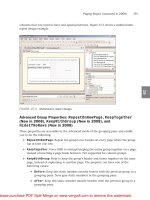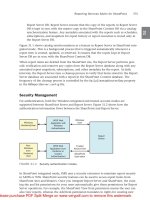Tài liệu Sybex - Mastering SQL Server 2008 (2009)01 ppt
Bạn đang xem bản rút gọn của tài liệu. Xem và tải ngay bản đầy đủ của tài liệu tại đây (736.38 KB, 40 trang )
MASTERING
SQL Server
®
2008
Lee
Bieker
Harness the Powerful New
Features of SQL Server 2008
Whether you’re a database administrator or application developer, this
in-depth guide is your key to delivering improved data collection, storage, re-
porting, and security with SQL Server 2008. Mastering SQL Server 2008 brings
you up to speed on architecture, installation, and confi guration essentials,
before moving to the step-by-step instruction you need for more advanced
topics such as procedural programming, query optimization, how to use spatial
data, SQL Server in the .NET world, and more.
You’ll master the extensive toolset, explore useful third-party tools, and most
importantly, fi nd out how to choose and use the right SQL Server features for
the specifi c tasks you have.
COVERAGE INCLUDES:
• Installing and confi guring SQL Server 2008
• Understanding SQL Server’s place within the Microsoft architecture
• Making data reliably and effi ciently available to your consumers
• Securing your data with SQL Server 2008’s new Transparent Data
Encryption feature
• Integrating XML technology into SQL Server
• Creating index architectures for maximum benefi t and minimum cost
• Exploring new geometry and geography data types for today’s businesses
• Maximizing data warehousing and business intelligence tools
Master the New Features
of SQL Server 2008
Migrate Smoothly from
Other Major RDBMS to
SQL Server 2008
Discover Practical Tools
and Techniques, Whether
You’re a Developer or
Administrator
Implement and Optimize
Security to Protect Your
Data Resources
Learn in the Context of
Real-World Scenarios and
Tasks
ABOUT THE AUTHORS
Michael Lee, MCT, MCITP, MCPD, SCJP, has been teaching SQL Server since 1995. Over the last 13 years, Michael has provided training
and consulting services in SQL Server and Enterprise Data Architecture to companies across the U.S. and Europe. Gentry Bieker, MCT,
MCITP, MCDBA, MCSE, has been a consultant, mentor, and trainer since 1998. He has been architecting, developing, and administering
SQL Server databases since version 6.0.
www.sybex.com
ISBN 978-0-470-28904-4
CATEGORY
COMPUTERS/Database Management/General
$59.99 US
$65.99 CAN
SERIOUS SKILLS.
Microsoft
®
SQL Server
®
2008
MASTERING
Michael Lee
Gentry Bieker
Install, Confi gure, and
Manage SQL Server 2008
Optimize, Troubleshoot, and
Secure Your Database
Microsoft
®
89044ffirs.indd 8 12/3/08 12:28:41 AM
Mastering
SQL Server
®
2008
89044ffirs.indd 1 12/3/08 12:28:28 AM
89044ffirs.indd 2 12/3/08 12:28:33 AM
Mastering
SQL Server
®
2008
Michael Lee
Gentry Bieker
89044ffirs.indd 3 12/3/08 12:28:39 AM
Acquisitions Editor: Agatha Kim
Development Editor: Laurene Sorensen
Technical Editor: Acey Bunch
Production Editor: Christine O’Connor
Copy Editor: Kathy Grider-Carlyle
Production Manager: Tim Tate
Vice President and Executive Group Publisher: Richard Swadley
Vice President and Publisher: Neil Edde
Book Designer: Maureen Forys, Happenstance Type-O-Rama; Judy Fung
Compositor: Jeffrey Lytle, Happenstance Type-O-Rama
Proofreader: Scott Klemp, Word One
Cover Designer: Ryan Sneed
Cover Image: © Pete Gardner / Digital Vision / Getty Images
Copyright © 2009 by Wiley Publishing, Inc., Indianapolis, Indiana
Published simultaneously in Canada
ISBN: 978-0-470-28904-4
No part of this publication may be reproduced, stored in a retrieval system or transmitted in any form or by any means, electronic, mechan-
ical, photocopying, recording, scanning or otherwise, except as permitted under Sections 107 or 108 of the 1976 United States Copyright Act,
without either the prior written permission of the Publisher, or authorization through payment of the appropriate per-copy fee to the
Copyright Clearance Center, 222 Rosewood Drive, Danvers, MA 01923, (978) 750-8400, fax (978) 646-8600. Requests to the Publisher for per-
mission should be addressed to the Permissions Department, John Wiley & Sons, Inc., 111 River Street, Hoboken, NJ 07030, (201) 748-6011,
fax (201) 748-6008, or online at />Limit of Liability/Disclaimer of Warranty: The publisher and the author make no representations or warranties with respect to the accu-
racy or completeness of the contents of this work and specifically disclaim all warranties, including without limitation warranties of fitness
for a particular purpose. No warranty may be created or extended by sales or promotional materials. The advice and strategies contained
herein may not be suitable for every situation. This work is sold with the understanding that the publisher is not engaged in rendering legal,
accounting, or other professional services. If professional assistance is required, the services of a competent professional person should be
sought. Neither the publisher nor the author shall be liable for damages arising herefrom. The fact that an organization or Web site is
referred to in this work as a citation and/or a potential source of further information does not mean that the author or the publisher
endorses the information the organization or Web site may provide or recommendations it may make. Further, readers should be aware that
Internet Web sites listed in this work may have changed or disappeared between when this work was written and when it is read.
For general information on our other products and services or to obtain technical support, please contact our Customer Care Department
within the U.S. at (800) 762-2974, outside the U.S. at (317) 572-3993 or fax (317) 572-4002.
Wiley also publishes its books in a variety of electronic formats. Some content that appears in print may not be available in electronic books.
Library of Congress Cataloging-in-Publication Data
Lee, Michael.
Mastering SQL server 2008 / Michael Lee, Gentry Bieker. — 1st ed.
p. cm.
Includes index.
ISBN 978-0-470-28904-4 (paper/website)
1. Client/server computing. 2. SQL server. 3. Relational databases. I. Bieker, Gentry. II. Title.
QA76.9.C55L45 2009
005.75’85—dc22
2008042924
TRADEMARKS: Wiley, the Wiley logo, and the Sybex logo are trademarks or registered trademarks of John Wiley & Sons, Inc. and/or its
affiliates, in theUnited Statesand other countries, and may not be used without written permission. SQL Server is a registered trademark of
Microsoft Corporation in the United States and/or other countries. All other trademarks are the property of their respective owners. Wiley
Publishing, Inc., is not associated with any product or vendor mentioned in this book.
10 9 8 7 6 5 4 3 2 1
89044ffirs.indd 4 12/3/08 12:28:39 AM
Dear Reader,
Thank you for choosing Mastering SQL Server 2008. This book is part of a family of premium-
quality Sybex books, all of which are written by outstanding authors who combine practical
experience with a gift for teaching.
Sybex was founded in 1976. More than thirty years later, we’re still committed to producing con-
sistently exceptional books. With each of our titles we’re working hard to set a new standard for
the industry. From the paper we print on, to the authors we work with, our goal is to bring you
the best books available.
I hope you see all that reflected in these pages. I’d be very interested to hear your comments and
get your feedback on how we’re doing. Feel free to let me know what you think about this or any
other Sybex book by sending me an email at n e d d e @ w ile y.co m, or if you think you’ve found a
technical error in this book, please visit . Customer feedback is criti-
cal to our efforts at Sybex.
Best regards,
Neil Edde
Vice President and Publisher
Sybex, an Imprint of Wiley
89044ffirs.indd 5 12/3/08 12:28:40 AM
To our students, who forced us to
continually improve.
89044ffirs.indd 6 12/3/08 12:28:40 AM
Acknowledgments
Every project of this size is always an intense collaboration. This was certainly no exception. It
all starts with the wonderful team at Sybex. This is the seventh project that I have worked on
with the Sybex team, and I am always impressed by the work that they do. Special thanks to
Neil Edde, Pete Gaughan, and Agatha Kim for their magnificent work on managing this pro-
cess. Thanks also to our editor, Laurene Sorensen, who was able to merge our ideas together
and help us to make the technical content actually readable. And thanks to the production team
of Christine O’Connor, Kathy Grider-Carlyle, and Scott Klemp. Acey Bunch was a spectacular
technical editor; an accomplished author in his own right, he provided many insights on the
content that proved invaluable and substantially improved the quality of the content. Gentry
Bieker, my coauthor on this project, was able to really capture the essence of SQL Server in the
real world, something with which he has extensive experience. The production team at Sybex is
superb. They were even able to take my hand drawings and turn them into real graphics, a true
feat if you have ever seen my handwriting.
Finally, on a personal note, my career in training and technology would never have taken
off had it not been for a former mentor, Bob Taylor. Other colleagues including Jon Hansen,
Dale Byrd, Bryan Bechtoldt, Ken Sandlin, and Mike Mansfield have contributed so much to
my career and given me amazing support over the years. Additionally, most of this work was
written while I was employed at Aristocrat Technologies in Las Vegas, and I need to thank my
colleagues and the management there for their support and input. And of course, I need to offer
special thanks to my family, my wife and son, who always pay the highest price for these proj-
ects as I lock myself into the office every weekend to write. They have been incredibly support-
ive as the process continued week after week, and I could not have done it without them.
Most importantly, thanks to you, the reader. You are the reason for this project in the first
place. I hope that you find value in the pages. Without you, we would not have had this incred-
ible opportunity. Your feedback is invaluable and will help make any future projects better and
more relevant. Good luck in your undertakings with SQL Server 2008. I wish you the best in
your endeavors.
—Michael Lee
I’m incredibly thankful for the level of support I’ve received from everyone while writing my
portion of this book. Thanks to Jennifer Hanner for all of the sacrifices she made, and the trips
she allowed me to miss in order to complete this book, helping to keep me sane, and encourag-
ing me to keep going through the process. To Samantha and Joel, my children, who went on
many trips and outings without me through during the writing process. They made me smile,
and reminded me that there is more to life than just a book. To Joel: “Yes, I’m finally done with
my chapter!” To Michael Lee, who gave me this fantastic opportunity and introduced me to the
process, and has always been patient and understanding in my learning about what it takes to
put together a book of this size. Thanks to the entire book team: Laurene Sorensen, Acey Bunch,
Pete Gaughan, Agatha Kim, and Neil Edde. I had an incredible amount of help and support
from everyone I’ve encountered at Sybex and Wiley. You have all given me a ton of respect for
the process that goes into creating a book. And to every one of my students (especially the dif-
ficult ones), who helped me to make it to where I am today.
—Gentry Bieker
89044ffirs.indd 7 12/3/08 12:28:40 AM
89044ffirs.indd 8 12/3/08 12:28:41 AM
About the Authors
Michael Lee (MCT, MCPD, MCITP, SCJP) has spent the last 15 years in technology training and
consulting. Most of his career has been spent working with companies and helping them ease
the transition to new technologies and practices. With a degree in Business Finance from the
University of Utah, Michael discovered early that he enjoyed the IT aspects of business and built
a career bringing together businesses and IT professionals, helping them understand each other
and improve communication.
His beginnings in IT were a bit dubious, having worked as an intern with IBM in 1988 on the
FAA modernization project (AAS), which has been dubbed one of the greatest project failures
in IT history. A lot was learned from that experience, and since then, his focus has been bring-
ing together business and technology interests. As a former Microsoft Regional Director, he was
heavily involved in the rollout of Visual Studio 6.0 in 1997 and has made a career out of melding
business and technology into a unified strategic front.
Currently, Michael is employed with the Clark County Court System in Las Vegas, Nevada
where he still gets a chance to get his hands dirty with all kinds of technology, applying his pas-
sion to the public sector. When he is not coding, writing, or spending time with family, you can
usually find him on his Harley, looking for that next great American Road.
Gentry Bieker is a certified trainer, consultant, and mentor who has focused on SQL Server and
related technologies for the last decade. His experience spans from database design and tuning
to application development and enterprise application integration. He has developed numerous
presentations, classes, and sessions on SQL Server and many of the other Microsoft technolo-
gies that work with SQL Server. In addition to SQL Server, he also focuses on SharePoint and
Microsoft CRM. He has worked with customers in many industries, spanning from health care
and insurance to casino gaming and manufacturing.
As an energetic and passionate individual, he has found that turning massive amounts
of data into useful information is what gets him up in the morning. He’s provided training,
mentoring, and consulting services for many companies, large and small, including Microsoft,
Unisys, and Kimberly-Clark. In his spare time, he enjoys spending time with his children, jump-
ing out of perfectly good airplanes, and gaming.
89044ffirs.indd 9 12/3/08 12:28:41 AM
Contents at a Glance
Introduction xxiii
Chapter 1 • Overview of Microsoft SQL Server 2008 1
Chapter 2 • Understanding SQL Server Architecture 35
Chapter 3 • Databases, Files, and Resource Management 65
Chapter 4 • Tables and CRUD Operations 89
Chapter 5 • Procedural Programming 133
Chapter 6 • Managing Data Integrity 163
Chapter 7 • SQL Server and XML 189
Chapter 8 • Managing User Security 223
Chapter 9 • Data Recovery 253
Chapter 10 • Monitoring SQL Server Activity 283
Chapter 11 • Using the SQL Server Agent Service 319
Chapter 12 • Data Availability and Distribution 349
Chapter 13 • SQL Server Data Security 389
Chapter 14 • Indexing Strategies for Query Optimization 415
Chapter 15 • Transactions and Locking 443
Chapter 16 • Using the Resource Governor and Policy-Based Management 473
Chapter 17 • SQL Server and the .NET Client . . . . . . . . . . . . . . . . . . . . . . . . . . . . . . . . 503
Chapter 18 • SQL Server and the Common Language Runtime 539
Chapter 19 • Using Spatial Data 569
Chapter 20 • Service-Oriented Architecture and the Service Broker . . . . . . . . . . . . . 595
Chapter 21 • Full-Text Search Services 623
89044ffirs.indd 10 12/3/08 12:28:42 AM
Appendices . . . . . . . . . . . . . . . . . . . . . . . . . . . . . . . . . . . . . . . . . . . . . . . . . . . . . . . . . . . . . . 653
Appendix A • The Bottom Line 655
Appendix B • SQL Server Analysis Services Overview 693
Appendix C • SQL Server 2008 Reporting Services 709
Index 723
89044ffirs.indd 11 12/3/08 12:28:42 AM
89044ffirs.indd 12 12/3/08 12:28:42 AM
Contents
Introduction xxiii
Chapter 1 • Overview of Microsoft SQL Server 2008 1
SQL Server in the Enterprise World 1
The Need for an Enterprise System 2
SQL Server Features 3
SQL Server’s Place Within Microsoft Architecture 6
SQL Server Licensing 8
Installing SQL Server 2008 10
Defining an Installation Plan 10
SQL Server 2008 Installation Requirements 16
The SQL Server Installation Process 17
Verifying the Installation 26
The SQL Server Tool Set 28
The Microsoft Client Tools 28
Third-Party Tools and Utilities 32
The Bottom Line 33
Chapter 2 • Understanding SQL Server Architecture 35
Essential Internals 35
SQL Server Data Storage Architecture 35
The Data Engine 44
SQL Server and Windows 47
The SQL Server System Catalog 48
The System Databases 48
System Tables, Views, and Functions 49
System Stored Procedures 55
Datatyping 57
System-Defined Datatypes 57
User-Defined Datatypes 60
The Bottom Line 63
Chapter 3 • Databases, Files, and Resource Management 65
Planning a Database 65
Planning for Database Usage 65
Planning for Recovery . . . . . . . . . . . . . . . . . . . . . . . . . . . . . . . . . . . . . . . . . . . . . . . . . . . . 66
Capacity Planning 68
89044ftoc.indd 13 12/3/08 2:48:34 PM
XIV
|
Contents
Creating Databases 69
Creating the Database 70
Manipulating Database Options 75
Managing Databases, Files, and Filegroups 78
Altering a Database 78
Growing and Shrinking Databases and Files 82
Creating Database Snapshots 86
The Bottom Line 88
Chapter 4 • Tables and CRUD Operations 89
Designing Data Storage 89
Implementing a Normalized Design 90
Denormalization 94
Creating and Dropping SQL Server Tables 96
The Basics of Table Creation 96
Computed Columns in Tables 98
Dropping Tables 100
Table Partitioning 100
Selecting Data from a Table 105
Aggregation and Grouping 106
Joins and Table Correlation 109
Subqueries, Derived, and Temporary Tables 113
Common Table Expressions 118
Modifying Data 122
The INSERT Process 122
The DELETE Process 124
The UPDATE Process 126
The MERGE Process 127
Using the OUTPUT Clause 129
The Bottom Line 130
Chapter 5 • Procedural Programming 133
Procedural Structures 133
Batches 133
Variables 135
Control-of-Flow Statements 136
Error Management 138
Basic Transaction Processing 142
Stored Procedures 144
Designing Effective Stored Procedures 145
Creating and Executing a Simple Stored Procedure 146
Using Parameters 147
Managing Return Values 151
Understanding Compilation 151
Views 153
Why Use Views? . . . . . . . . . . . . . . . . . . . . . . . . . . . . . . . . . . . . . . . . . . . . . . . . . . . . . . . . 154
Standard Views 154
89044ftoc.indd 14 12/3/08 2:48:35 PM
Contents
|
XV
User-Defined Functions 155
Functions Versus Stored Procedures 156
Built-In Functions Revisited 157
Scalar Functions 157
Table-Valued Functions 159
Using Synonyms 161
Why Use Synonyms? 161
Creating a Synonym 161
The Bottom Line 162
Chapter 6 • Managing Data Integrity 163
Understanding Data Integrity Controls 163
Enforcing Data Integrity 164
Data Integrity Categories 164
Working with Constraints 165
Primary Key and Unique Constraints 165
Foreign Key Constraints 168
Default Definitions 172
Check Constraints 174
Working with DML Triggers 175
Understanding Triggers 176
Using AFTER Triggers 179
Using INSTEAD OF Triggers 183
Special Considerations 185
Rule and Default Objects 186
Default Objects 186
Rules 187
The Bottom Line 187
Chapter 7 • SQL Server and XML 189
Returning XML from SQL Server Using FOR XML 189
Creating XML with RAW Mode Queries 190
Creating XML with AUTO Mode Queries 192
Creating XML with EXPLICIT Mode Queries 195
Creating XML with PATH Mode Queries 198
The xml Datatype 200
Implementing the x ml Datatype 201
Shredding XML Data to Relational Output 203
Validating XML with Schemas 205
Using the XML Schema Collection 206
Using Namespaces in Schemas 207
Implementing XQuery 208
Simple XQuery Expressions 208
Structuring Complex XQuery Syntax 209
Creating an XML Structure with XQuery 211
XQuery and Namespaces 212
Other XML Datatype Methods 215
89044ftoc.indd 15 12/3/08 2:48:37 PM
XVI
|
Contents
XML Indexes 218
The Bottom Line 221
Chapter 8 • Managing User Security 223
The SQL Server Security Infrastructure 223
SQL Server 2008 Security Architecture 224
Implementing SQL Server Principals and Authentication 231
Implementing Logins 231
Implementing Users 237
Implementing Roles 239
Implementing Permissions in SQL Server 242
Understanding Permission Behavior 243
Setting Permissions 244
Ownership Chains 249
The Bottom Line 250
Chapter 9 • Data Recovery 253
Transaction Architecture 253
Database Recovery Models 254
The Internals of Transaction Logging 254
How Transaction Logging Is Used 255
Backup and Restore Strategies 257
Recovery Models and Backup Strategy 258
Backup Types 260
Performing Backups 260
Full Backups 261
Backup Devices, Media Sets, and Media Families 261
Differential Backups 263
Transaction Log Backups 264
Partial Backups 264
Creating Backups Using Management Studio 265
Performing Restores 267
Retrieving Backup Metadata 267
Performing a Complete Restore 268
Performing Point in Time Recovery 271
Performing a File or Filegroup Restore 273
Performing Page Restore Operations 275
Using SQL Server Management Studio to Restore a Database 275
Other Issues 277
System Database Recovery 277
Backup Security 279
Backup Performance and Optimization 280
Backup Compression 280
The Bottom Line 281
89044ftoc.indd 16 12/3/08 2:48:39 PM
Contents
|
XVII
Chapter 10 • Monitoring SQL Server Activity 283
Using System Monitor 283
Basic Monitoring Concepts . . . . . . . . . . . . . . . . . . . . . . . . . . . . . . . . . . . . . . . . . . . . . . . 284
Graphs, Logs, and Alerts 286
Selecting Resources and Counters 287
Using SQL Profiler & Trace 290
Designing a Good Trace 290
Selecting Data Columns and Events 291
Evaluating Trace Output 297
Replaying Traces for Performance Analysis 301
DDL Triggers 305
DDL Triggers Versus DML Triggers 306
Trigger Events 307
EVENTDATA and Its Schema 311
Event Notifications 314
Event Notifications Versus DDL Triggers 315
Event Classes 315
Implementing Event Notifications 315
The Bottom Line 317
Chapter 11 • Using the SQL Server Agent Service 319
SQL Agent and Automation 319
Reducing Administration Overhead 319
The SQL Server Agent Architecture 320
Configuring the SQL Agent Service 323
Creating Jobs 328
Creating Jobs 328
Creating Job Steps 330
Creating Schedules 335
Executing Jobs 336
Creating Alerts 337
Monitoring the Event Log 338
Responding to Performance Alerts 340
Understanding WMI Alerts 340
Creating Operators 341
Operator Types 341
Configuring Operators 342
Associating Operators with Jobs and Alerts 343
Scripting the SQL Agent 344
Understanding the SQL Agent System Stored Procedures 344
Scripting Existing Jobs 345
The Bottom Line 347
89044ftoc.indd 17 12/3/08 2:48:40 PM
XVIII
|
Contents
Chapter 12 • Data Availability and Distribution 349
Overview of SQL Server Availability and Distribution Options 349
Hardware Considerations 350
SQL Server Features 352
Database Log Shipping 355
Configuring Log Shipping 356
Failing Over in a Log Shipping Scenario 365
Database Mirroring 366
Configuring Database Mirroring 366
Exploring the Mirroring Solution 373
Replication 374
Replication Overview 374
Configuring Replication 376
The Bottom Line 386
Chapter 13 • SQL Server Data Security 389
Understanding the SQL Server Key Infrastructure 389
The SQL Server Keys 390
Extensible Key Management 399
Backing Up the Keys 400
Using Transparent Data Encryption 401
Creating Keys and Certificates 402
Encrypting Data Using SQL Server 403
Understanding Authenticators 404
Encryption with Passphrases 404
Encryption with Symmetric Keys 405
Encryption with Asymmetric Keys 406
Encryption with Certificates 408
Module Signing 411
The Bottom Line 413
Chapter 14 • Indexing Strategies for Query Optimization 415
Index Architecture 415
Index Basics 416
Data Heaps 418
Clustered Indexes 422
Nonclustered Indexes 424
Planning Clustered and Nonclustered Indexes 426
Creating and Managing Indexes 430
Creating Indexes with SSMS 430
Managing Indexes and Fragmentation with SSMS 432
Creating and Managing Indexes with TSQL 436
Special Index Considerations 439
Covering a Query 439
Logical Operator Processing 440
The Bottom Line 441
89044ftoc.indd 18 12/3/08 2:48:42 PM
Contents
|
XIX
Chapter 15 • Transactions and Locking 443
The SQL Server Locking Architecture . . . . . . . . . . . . . . . . . . . . . . . . . . . . . . . . . . . . . . . . 443
What Gets Locked 444
Types of Locks 446
Controlling Locks 448
Managing Deadlocks 452
Transaction Management 453
SQL Server Transaction Concepts 453
Implementing Explicit Transactions 454
Using Savepoints 456
Transactions and Errors 458
Concurrency and Performance 459
Distributed Transactions 460
Understanding Distributed Queries 461
Defining Distributed Transactions 466
Getting Transaction and Locking Information 468
Using the Activity Monitor Utility 468
Using Transact-SQL to Monitor Activity 469
The Bottom Line 471
Chapter 16 • Using the Resource Governor and
Policy-Based Management 473
The Resource Governor 473
Workload Groups 475
Resource Pools 478
Understanding Policy-Based Management 482
Policy-Based Management Components 483
Creating and Evaluating Policies 491
The Bottom Line 501
Chapter 17 • SQL Server and the .NET Client 503
Understanding ADO.NET 503
Making the Connection 505
Defining the Command 507
Connected Operations 509
Disconnected Operations 512
Special Operations in ADO.NET 515
Multiple Active Result Sets (MARS) 515
Using SQLBulkCopy 516
SQL Query Notifications 518
Introducing Language Integrated Query (LINQ) 522
Different Flavors of LINQ 523
LINQ to SQL 524
The SQL Server Implications of LINQ to SQL 528
LINQ and the Entity Framework 530
Creating and Querying the Entity Data Model 531
The SQL Server Implications of the Entity Framework 533
The Bottom Line 536
89044ftoc.indd 19 12/3/08 2:48:45 PM
XX
|
Contents
Chapter 18 • SQL Server and the Common Language Runtime 539
CLR Concepts 539
CLR Terminology 540
Enabling the CLR 541
Creating Managed Objects in SQL Server . . . . . . . . . . . . . . . . . . . . . . . . . . . . . . . . . . . . . 542
Setting Up the Project Environment 543
Creating Managed Functions 545
Creating Managed Stored Procedures 550
Create Managed Datatypes 553
Deploying Managed Objects in SQL Server 555
Creating Assemblies 555
Creating Managed Objects 559
Managing CLR Security 562
Managed Objects and User Security 562
Assemblies and Code Access Security 563
Security Considerations 567
The Bottom Line 568
Chapter 19 • Using Spatial Data 569
Spatial Data Concepts 569
The Foundation 569
Geometry Versus Geography 571
Shapes Supported by Spatial Data 572
Defining Spatial Storage 574
Implementing the Geom et ry Type 575
Loading Geometry Data 575
Working with Points and MultiPoints 577
Working with LineStrings and MultiLineStrings . . . . . . . . . . . . . . . . . . . . . . . . . . . . 579
Working with Polygons and MultiPolygons 581
Using the GeometryCollection 584
Implementing the G eogra phy Type 584
Understanding the Spatial Reference 584
Geometry Versus Geography 586
Spatial Indexes 587
Spatial Index Architecture and Restrictions 588
Creating Spatial Indexes 589
The Bottom Line 592
Chapter 20 • Service-Oriented Architecture and the Service Broker 595
The Essentials of Service-Oriented Architecture 595
SOA Distilled 595
Service Architecture 599
Understanding the Service Broker 602
Service Broker Terminology 602
Service Broker Workflow Scenario 604
89044ftoc.indd 20 12/3/08 2:48:46 PM
Contents
|
XXI
Implementing Service Broker 607
Creating Service Broker Components 607
Constructing a Service Broker Dialog 614
The Bottom Line 620
Chapter 21 • Full-Text Search Services 623
Full-Text Architecture 623
Full-Text Terminology 623
Architecture 625
Creating Full-Text Indexes 627
Creating Stoplists 628
Creating a Full-Text Catalog 632
Creating Full-Text Indexes 635
Writing Full-Text Queries 643
Implementing the CONTAINS Predicate 644
Implementing the FREETEXT Predicate 648
Implementing the Full-Text Functions 648
The Bottom Line 651
Appendices . . . . . . . . . . . . . . . . . . . . . . . . . . . . . . . . . . . . . . . . . . . . . . . . . . . . . . . . . . . . . . 653
Appendix A • The Bottom Line 655
Chapter 1: Overview of Microsoft SQL Server 2008 655
Chapter 2: Understanding SQL Server Architecture 657
Chapter 3: Databases, Files, and Resource Management 659
Chapter 4: Tables and CRUD Operations 660
Chapter 5: Procedural Programming 662
Chapter 6: Managing Data Integrity 663
Chapter 7: SQL Server and XML 664
Chapter 8: Managing User Security 666
Chapter 9: Data Recovery 668
Chapter 10: Monitoring SQL Server Activity 671
Chapter 11: Using the SQL Server Agent Service 672
Chapter 12: Data Availability and Distribution 673
Chapter 13: SQL Server Data Security 675
Chapter 14: Indexing Strategies for Query Optimization 676
Chapter 15: Transactions and Locking 678
Chapter 16: Using the Resource Governor and Policy-Based Management 680
Chapter 17: SQL Server and the .NET Client 680
Chapter 18: SQL Server and the Common Language Runtime 683
Chapter 19: Using Spatial Data 685
Chapter 20: Service-Oriented Architecture and the Service Broker 687
Chapter 21: Full-Text Search Services 690
89044ftoc.indd 21 12/3/08 2:48:48 PM
XXII
|
Contents
Appendix B • SQL Server Analysis Services Overview 693
Designing the Data Warehouse 693
Data Warehouse Defined 694
Dimensional Data Models 694
Understanding Analysis Services 696
Creating Data Cubes 697
Creating a Data Source 698
Creating a Data Source View 700
Creating a Dimension 701
Deploying the Project 703
Creating a Cube 704
Browsing a Cube 707
Appendix C • SQL Server 2008 Reporting Services 709
Configuring Reporting Services 709
Starting and Locating Reporting Services Ports 710
Loading the Report Manager 711
Creating a Simple Report 712
Defining the Report Project 712
Creating a Data Source 713
Creating a Report 715
Designing the Report 717
Deploying the Report 719
Index 723
89044ftoc.indd 22 12/3/08 2:48:49 PM
Introduction
Database technology is constantly evolving. The interplay among major database vendors such
as Microsoft and Oracle, as well as the inevitable pressure of the open-source community, has
demanded that database systems continue to push forward in both features and scalability. This
fact means that the everyday database professional is constantly in a “catch up” mode. This book
is an attempt to simplify that process by distilling the flood of information available.
The very nature of a book like this, where the subject matter is so broad, is to ensure that the
important points get included, but we can’t possibly include everything that SQL Server 2008
supports. In fact, the authors had numerous long conversations, not about what we had to put
into the book, but the trade-offs of what we had to leave out. We tried to find a balance, provid-
ing at least general coverage of the most important topics. This meant that we had to sacrifice
the “deep dive” in some situations to ensure that we could address as much as possible without
overloading the reader.
The other victim to this approach was an extensive coverage of the basics. Although we have
included some introductory material, we had to make the assumption that this is not the first
SQL Server book that you, the reader, have ever picked up. Although this is not an upgrader’s
guide, it does assume that you have had some prior experience with SQL Server and are looking
to get a firm understanding about the capabilities and mechanics of the tool. We also put a focus
on addressing the important new features as much as we could, so that you can quickly add
these to your toolbelt. Hopefully, we have hit the mark we were aiming for.
We have also attempted to create a work that could be valuable as a reference as well as being
read from cover to cover. The chapters address major topic areas so you should be able to drill
into the information that you need. This book can, therefore, act as a roadmap, but we would
encourage you to consult the SQL Server Books Online as well. There is a wealth of information
there and some good code examples.
Finally, we hope that this book will be an easy and entertaining read. Our biggest complaint
about technical books over the years is that they are far too sterile and take themselves too seri-
ously. We have been teaching this stuff for years and have found that you can’t take yourself or
the subject matter too seriously if you want to engage your audience, so enjoy. We have had a
wonderful time putting this together for you.
Who Should Read This Book
Our target audience is the database professional with some SQL Server experience who is either:
Trying to ramp up skills on SQL Server 2008, or
•u
Transitioning from another RDBMS to SQL Server•u
89044flast.indd 23 12/3/08 12:29:49 AM









